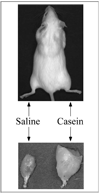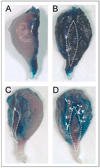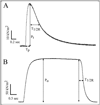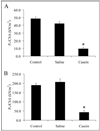Induction of muscle weakness by local inflammation: an experimental animal model
- PMID: 19205846
- PMCID: PMC2790866
- DOI: 10.1007/s00011-008-8093-7
Induction of muscle weakness by local inflammation: an experimental animal model
Abstract
Objective and design: The objective of this study was to characterize the response of skeletal muscle to a localized inflammation induced by the inflammatory agent casein.
Methods: An inflammatory agent, casein, was injected into the right hindlimb and saline was injected into the left hindlimb of normal adult mice, once daily for six consecutive days. Inflammatory response was monitored by immunohistochemical labeling of leukocytes. Muscle protein levels were determined by electrophoresis and muscle function was determined by isometric force measurements.
Results: Local inflammation was induced by casein in association with the accumulation of extensive neutrophils and macrophages in the soleus muscle. This local inflammation resulted in a shift in myosin heavy chain (MHC) isoform expression and a significant reduction in total MHC concentration in the soleus. Maximal twitch and tetanic forces were significantly reduced in the inflamed soleus. Contractile function in soleus was fully restored after two weeks of recovery, along with the restoration of protein concentration and the disappearance of inflammatory cells.
Conclusion: This study establishes a unique and robust model in which mechanisms of local inflammation induced muscle protein degradation, reduction of contractile force, and subsequent recovery from this condition can be further studied.
Figures










Similar articles
-
Tetanic contraction induces enhancement of fatigability and sarcomeric damage in atrophic skeletal muscle and its underlying molecular mechanisms.Zhongguo Ying Yong Sheng Li Xue Za Zhi. 2013 Nov;29(6):525-33. Zhongguo Ying Yong Sheng Li Xue Za Zhi. 2013. PMID: 24654535
-
Skeletal muscle weakness caused by carrageenan-induced inflammation.Muscle Nerve. 2012 Sep;46(3):413-20. doi: 10.1002/mus.23318. Muscle Nerve. 2012. PMID: 22907233
-
Deficiency of alpha-sarcoglycan differently affects fast- and slow-twitch skeletal muscles.Am J Physiol Regul Integr Comp Physiol. 2005 Nov;289(5):R1328-37. doi: 10.1152/ajpregu.00673.2004. Epub 2005 Jul 7. Am J Physiol Regul Integr Comp Physiol. 2005. PMID: 16002556
-
Effects of long-term creatine feeding and running on isometric functional measures and myosin heavy chain content of rat skeletal muscles.Pflugers Arch. 2006 Sep;452(6):744-55. doi: 10.1007/s00424-006-0079-0. Epub 2006 May 11. Pflugers Arch. 2006. PMID: 16688465
-
Contractility and myosin isoform compositions of skeletal muscles and muscle cells from rats treated with thyroid hormone for 0, 4 and 8 weeks.J Muscle Res Cell Motil. 1997 Jun;18(3):335-44. doi: 10.1023/a:1018674126229. J Muscle Res Cell Motil. 1997. PMID: 9172075
Cited by
-
Tumor growth increases neuroinflammation, fatigue and depressive-like behavior prior to alterations in muscle function.Brain Behav Immun. 2015 Jan;43:76-85. doi: 10.1016/j.bbi.2014.07.013. Epub 2014 Aug 4. Brain Behav Immun. 2015. PMID: 25102452 Free PMC article.
-
Effect of inflammation on handgrip strength in the non-critically ill is independent from age, gender and body composition.Eur J Clin Nutr. 2014 Feb;68(2):155-8. doi: 10.1038/ejcn.2013.261. Epub 2013 Dec 11. Eur J Clin Nutr. 2014. PMID: 24327120
-
Ageing prolongs inflammatory marker expression in regenerating rat skeletal muscles after injury.J Inflamm (Lond). 2011 Dec 29;8(1):41. doi: 10.1186/1476-9255-8-41. J Inflamm (Lond). 2011. PMID: 22206492 Free PMC article.
-
Insulin treatment reverses the increase in atrogin-1 expression in atrophied skeletal muscles of diabetic rats with acute joint inflammation.Ther Clin Risk Manag. 2018 Feb 14;14:275-286. doi: 10.2147/TCRM.S142948. eCollection 2018. Ther Clin Risk Manag. 2018. PMID: 29497304 Free PMC article.
References
-
- Verleye M, Heulard I, Stephens JR, Levy RH, Gillardin JM. Effects of citrulline malate on bacterial lipopolysaccharide induced endotoxemia in rats. Arzneimittelforschung. 1995;45:712–715. - PubMed
-
- Walsmith J, Roubenoff R. Cachexia in rheumatoid arthritis. Int J Cardiol. 2002;85:89–99. - PubMed
-
- Muscaritoli M, Bossola M, Aversa Z, Bellantone R, Rossi Fanelli F. Prevention and treatment of cancer cachexia: new insights into an old problem. Eur J Cancer. 2006;42:31–41. - PubMed
-
- Coats AJ. Origin of symptoms in patients with cachexia with special reference to weakness and shortness of breath. Int J Cardiol. 2002;85:133–139. - PubMed
-
- Sharma R, Anker SD. Cytokines, apoptosis and cachexia: the potential for TNF antagonism. Int J Cardiol. 2002;85:161–171. - PubMed
Publication types
MeSH terms
Substances
Grants and funding
LinkOut - more resources
Full Text Sources
Research Materials

